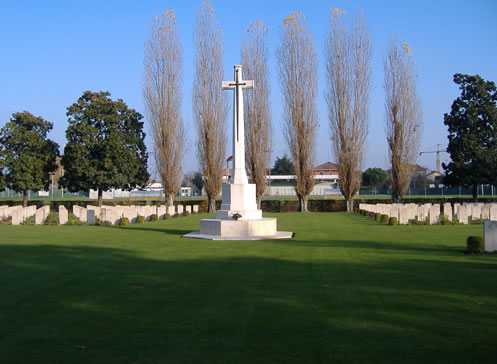Cesena War Cemetery

On October 19, 1944, nearly one month after the Allies entered Rimini, the Allies found the town of Cesena likewise abandoned by the Germans. The enemy had wanted to withdraw two days earlier to prevent their being encircled by the Allies, but the German High Command insisted the town be held. The 200th Pazer Grenadier Regiment, unable to resist the Allied pressure, withdrew nonetheless, and established themselves behind the Savio River. On the 19th, the 1st Canadian Dvision advanced toward the town, meeting light resistance. Patrols from the Carleton and York Regiment entered Cesena's east side, while British infantrymen marched in from the south. By now, almost the entire German front line was behind the Savio.
That autumn, steady pressure against the enemy was the order of the day and the Allies continued their advance through lands converted into swamps by rain, flooding and destroyed dykes. By mid-October the Canadians had reached the Savio, but they had progressed only 15 miles north of Rimini. On the 24th, after four days of fighting to establish a bridgehead while under fire and with the water continually rising, they were firmly placed on the other side of the river and the Germans were again withdrawing. It was during the German counterattacks against the 1st Canadian Division on October 21-22 that Private Ernest Alvia (Smokey) Smith earned the Victoria Cross.
The end of October saw the Canadians, who had been almost constantly engaged in the campaign since August, withdrawn into reserve, except for the Governor General's Horse Guards, the Royal Canadian Dragoons, the Westminister Regiment, the mortars of the Princess Louise Fuliliers and some artillery and engineering units. These were attached to "Porterforce", a group fo British and Canadian armoured and atillery units commanded by L.Col. A.M. Hoursbrugh-Porter of the U.K.. They would not return to their parent units until the end of November. With the Eighth Army they continued what has been called the "advance across the rivers" to Ravenna. One bridgeless, swollen river, stream and canal after another presented itself as an obstacle on the way from Rimini to Ravenna. The Italian Committee of Liberation from Ravenna supported the Porterforce group, supplying information about positions, and they participated in the drive to Ravenna. In this advance, Porterforce secured the Eighth Army's right flank and captured 171 prisoners, at a cost of 30 Canadian casualities.
On November 9, the town of Forli fell to the Eighth Army's 4th Division and at the same time the entire front pushed north, driving the Germans back to Ravenna. As December began, the 1st Canadian Corps was back in action. While the 1st Infantry Division was struggling to cross the Lamone River, the 5th Armoured Division had advanced across the Montone River, forcing a further retreat by the enemy. The Italian partisans did their part in this campaign, raiding enemy patrols and isolated posts, and on December 2 they attacked German communications and rear installations around Ravenna. On the morning of the 3rd, the Lanark and Renfrew Scottish Regiment and the Westminister Regiment (motor) cleared the village of San Pancrazio. The Lanarks entered Godo that night. The main roads were now cleared and useful, quickening the pace of progress. The Westministers cleared Piangipane in the afternoon of December 4. The same day, the Germans were withdrawing again as the 4th Princess Louise Dragoon Guards outflanked Ravenna in an ecircling movement. A destroyed bridge prevented the tanks from reaching the city so Canadian infantry marched in, linking up with the 27th Lancers of Porterforce. The city was an especially welcome sight for an army now in need of new winter accommodiations.
Directions
The Cesena War Cemetery is located in the commune of Cesena and the province of Forli, on the provincial road to Cervia. It is a half-hour drive from Ravenna. The property was selected as a cemetery site in November 1944. One of the smaller war cemeteries, it contains 775 graves, of which 307 are Canadian, representing nearly every unit of the Canadian Corps. Most of those who are buried here fell in the nearby battlefields during the Allied advance from Rimini to Forli and beyond, between late September and early December of 1944.
- Date modified: